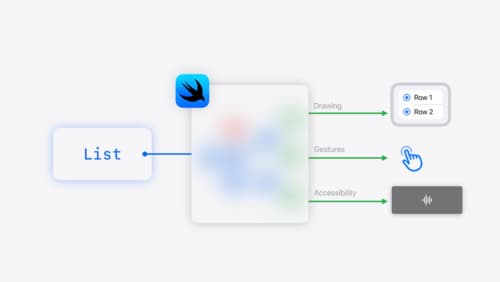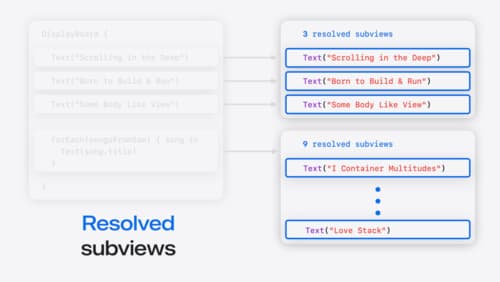how to build custom swiftui copomnents
Asked on 2024-08-05
1 search
To build custom SwiftUI components, you can leverage several techniques and APIs discussed in the WWDC sessions. Here are some key points and resources to help you get started:
-
Understanding Composition:
- SwiftUI allows you to create flexible and reusable components by composing different kinds of content together. For example, you can use a
ForEachview to generate views from data dynamically. - Demystify SwiftUI containers (03:07) discusses how to make your container more flexible by adding support for more kinds of composition in its content.
- SwiftUI allows you to create flexible and reusable components by composing different kinds of content together. For example, you can use a
-
Custom Container Views:
- SwiftUI provides many full-featured container views like
List, which use a trailingViewBuilderclosure to wrap their content. You can define content statically or dynamically. - Demystify SwiftUI containers (00:07) introduces building custom container views in SwiftUI, including using new APIs to support advanced capabilities like grouping content into sections and applying container-specific modifiers.
- SwiftUI provides many full-featured container views like
-
Low-Level Control and Custom Layouts:
- SwiftUI offers APIs for low-level control, such as creating custom control styles, using
Canvasfor high-performance imperative drawing, and applying custom Metal shaders directly to SwiftUI views. - SwiftUI essentials (15:57) covers how to create unique custom experiences using these low-level tools.
- SwiftUI offers APIs for low-level control, such as creating custom control styles, using
-
Declarative and Adaptive Views:
- SwiftUI views are declarative, compositional, and state-driven. You describe what view you want in your user interface, and SwiftUI produces the result.
- SwiftUI essentials (01:47) explains the fundamentals of views in SwiftUI, emphasizing their declarative nature.
-
Interoperability with UIKit and AppKit:
- SwiftUI seamlessly interoperates with UIKit and AppKit. You can use
UIViewRepresentableto create and update UIKit views within SwiftUI, andHostingViewControllerto embed SwiftUI views in UIKit or AppKit view hierarchies. - SwiftUI essentials (21:25) discusses SDK interoperability and how to integrate SwiftUI with existing UIKit or AppKit components.
- SwiftUI seamlessly interoperates with UIKit and AppKit. You can use
For more detailed guidance, you can refer to the following sessions:
These sessions provide comprehensive insights into building custom SwiftUI components and leveraging the full capabilities of the framework.

SwiftUI essentials
Join us on a tour of SwiftUI, Apple’s declarative user interface framework. Learn essential concepts for building apps in SwiftUI, like views, state variables, and layout. Discover the breadth of APIs for building fully featured experiences and crafting unique custom components. Whether you’re brand new to SwiftUI or an experienced developer, you’ll learn how to take advantage of what SwiftUI has to offer when building great apps.

Get started with HealthKit in visionOS
Discover how to use HealthKit to create experiences that take full advantage of the spatial canvas. Learn the capabilities of HealthKit on the platform, find out how to bring an existing iPadOS app to visionOS, and explore the special considerations governing HealthKit during a Guest User session. You’ll also learn ways to use SwiftUI, Swift Charts, and Swift concurrency to craft innovative experiences with HealthKit.

Demystify SwiftUI containers
Learn about the capabilities of SwiftUI container views and build a mental model for how subviews are managed by their containers. Leverage new APIs to build your own custom containers, create modifiers to customize container content, and give your containers that extra polish that helps your apps stand out.
